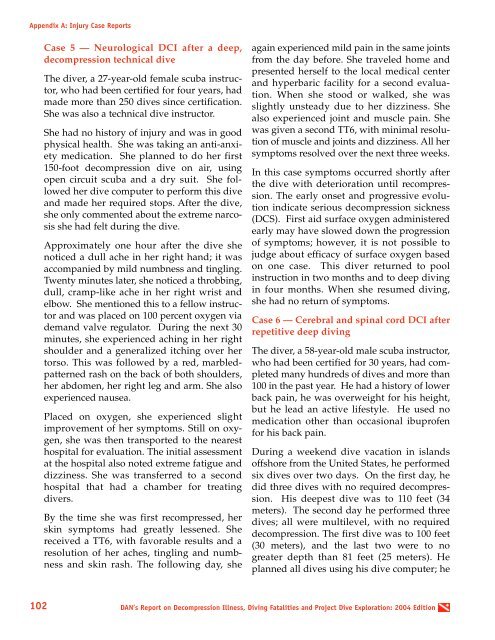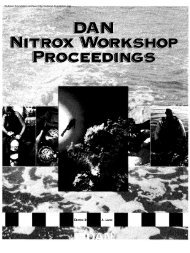Report on Decompression Illness, Diving Fatalities and Project Dive
Report on Decompression Illness, Diving Fatalities and Project Dive
Report on Decompression Illness, Diving Fatalities and Project Dive
- No tags were found...
You also want an ePaper? Increase the reach of your titles
YUMPU automatically turns print PDFs into web optimized ePapers that Google loves.
Appendix A: Injury Case <str<strong>on</strong>g>Report</str<strong>on</strong>g>sCase 5 — Neurological DCI after a deep,decompressi<strong>on</strong> technical diveThe diver, a 27-year-old female scuba instructor,who had been certified for four years, hadmade more than 250 dives since certificati<strong>on</strong>.She was also a technical dive instructor.She had no history of injury <strong>and</strong> was in goodphysical health. She was taking an anti-anxietymedicati<strong>on</strong>. She planned to do her first150-foot decompressi<strong>on</strong> dive <strong>on</strong> air, usingopen circuit scuba <strong>and</strong> a dry suit. She followedher dive computer to perform this dive<strong>and</strong> made her required stops. After the dive,she <strong>on</strong>ly commented about the extreme narcosisshe had felt during the dive.Approximately <strong>on</strong>e hour after the dive shenoticed a dull ache in her right h<strong>and</strong>; it wasaccompanied by mild numbness <strong>and</strong> tingling.Twenty minutes later, she noticed a throbbing,dull, cramp-like ache in her right wrist <strong>and</strong>elbow. She menti<strong>on</strong>ed this to a fellow instructor<strong>and</strong> was placed <strong>on</strong> 100 percent oxygen viadem<strong>and</strong> valve regulator. During the next 30minutes, she experienced aching in her rightshoulder <strong>and</strong> a generalized itching over hertorso. This was followed by a red, marbledpatternedrash <strong>on</strong> the back of both shoulders,her abdomen, her right leg <strong>and</strong> arm. She alsoexperienced nausea.Placed <strong>on</strong> oxygen, she experienced slightimprovement of her symptoms. Still <strong>on</strong> oxygen,she was then transported to the nearesthospital for evaluati<strong>on</strong>. The initial assessmentat the hospital also noted extreme fatigue <strong>and</strong>dizziness. She was transferred to a sec<strong>on</strong>dhospital that had a chamber for tre a t i n gdivers.By the time she was first recompressed, herskin symptoms had greatly lessened. Shereceived a TT6, with favorable results <strong>and</strong> aresoluti<strong>on</strong> of her aches, tingling <strong>and</strong> numbness<strong>and</strong> skin rash. The following day, sheagain experienced mild pain in the same jointsfrom the day before. She traveled home <strong>and</strong>presented herself to the local medical center<strong>and</strong> hyperbaric facility for a sec<strong>on</strong>d evaluati<strong>on</strong>.When she stood or walked, she wasslightly unsteady due to her dizziness. Shealso experienced joint <strong>and</strong> muscle pain. Shewas given a sec<strong>on</strong>d TT6, with minimal resoluti<strong>on</strong>of muscle <strong>and</strong> joints <strong>and</strong> dizziness. All hersymptoms resolved over the next three weeks.In this case symptoms occurred shortly afterthe dive with deteriorati<strong>on</strong> until recompressi<strong>on</strong>.The early <strong>on</strong>set <strong>and</strong> progressive evoluti<strong>on</strong>indicate serious decompressi<strong>on</strong> sickness(DCS). First aid surface oxygen administeredearly may have slowed down the progressi<strong>on</strong>of symptoms; however, it is not possible tojudge about efficacy of surface oxygen based<strong>on</strong> <strong>on</strong>e case. This diver returned to poolinstructi<strong>on</strong> in two m<strong>on</strong>ths <strong>and</strong> to deep divingin four m<strong>on</strong>ths. When she resumed diving,she had no return of symptoms.Case 6 — Cerebral <strong>and</strong> spinal cord DCI afterrepetitive deep divingThe diver, a 58-year-old male scuba instructor,who had been certified for 30 years, had completedmany hundreds of dives <strong>and</strong> more than100 in the past year. He had a history of lowerback pain, he was overweight for his height,but he lead an active lifestyle. He used nomedicati<strong>on</strong> other than occasi<strong>on</strong>al ibuprofenfor his back pain.During a weekend dive vacati<strong>on</strong> in isl<strong>and</strong>soffshore from the United States, he performedsix dives over two days. On the first day, hedid three dives with no required decompressi<strong>on</strong>.His deepest dive was to 110 feet (34meters). The sec<strong>on</strong>d day he performed threedives; all were multilevel, with no requireddecompressi<strong>on</strong>. The first dive was to 100 feet(30 meters), <strong>and</strong> the last two were to nogreater depth than 81 feet (25 meters). Heplanned all dives using his dive computer; he102DAN’s <str<strong>on</strong>g>Report</str<strong>on</strong>g> <strong>on</strong> Decompressi<strong>on</strong> <strong>Illness</strong>, <strong>Diving</strong> <strong>Fatalities</strong> <strong>and</strong> <strong>Project</strong> <strong>Dive</strong> Explorati<strong>on</strong>: 2004 Editi<strong>on</strong>
















